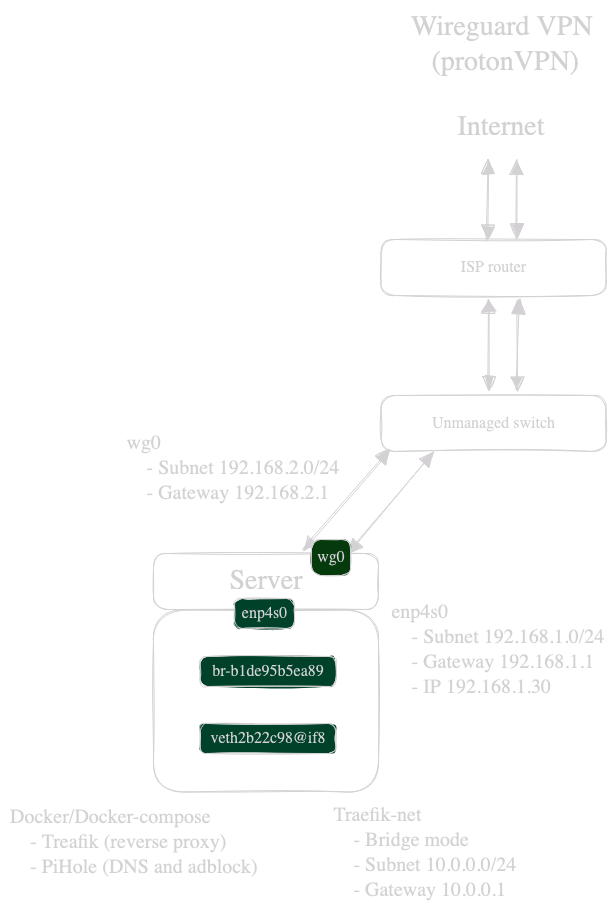Hey there, I've been on a networking journey that has, over a few years, taken me from simple unmanaged networking, to managed networking, to advanced VLAN management. It's all been self taught, but mostly successful. However, I've gotten myself into a bit of a pickle and I'm hitting a wall in troubleshooting. Apologies for the length of the post, however I want to provide as much detail as possible.
High level, I have several /16 vlans for things. VLAN 99 is networking, 2, is servers, 4 is clients, 6 is wireguard clients, and there are some others. They're all 10.99.0.0/16 with a gateway at 10.99.1.254, etc.
I have had a very old Netgear Layer3 switch for some time. I've replaced it with a Brocade ICX6610, mostly so I can move my storage infrastructure to 10G fiber (I have a small hypervisor cluster). I had done a ton of preparatory work to configure the new L3 switch so that it could just be dropped in place of the old one; this was MOSTLY successful...
...However, in doing that I broke the connection to my opnsense firewall and sort of had to redo that piece from scratch. During my planning, I didn't realize some of the config changes I'd made would require changes on the firewall, and after the cut over I was locked out of the firewall. This is all my fault; that's the piece of this I understand the least, and I had followed dodgy guides when getting it to initially work. I have a backup in xml format, but even having that I'm realizing what I had been doing didn't make sense. Previously, I had a firewall interface on all of my vlans and the trunk going to it was carrying all the VLANS. Now, I set this up with only 2 vlans going to the firewall, the networking vlan and the wireguard vlan, as it seems to make more sense with my understanding of how Layer 3 routing works. All routing should happen on the Brocade L3 switch. The firewall itself has 4 physical ports, 1 going to my comcast gateway, and 2 in an LACP lagg going to my L3 switch. (I have a single interface right now going to the L3 switch separately for troubleshooting, removing the LACP lag as a complexity source).
So, in recovering this, I had to get into the firewall at the console and re-define the interfaces and IP's. I got this to work, but at this point I had tons of connection problems which I didn't understand fully. I have found some of opnsense's configuration to be a bit obfuscating, which I think is making my learning more difficult. The following were put in place:
- The "LAN" interface was given a static 10.99.1.40/16 IP, and an upstream gateway was defined at 10.99.1.254.
- The "WAN" interface was given DHCP, and is up and works
Once I recovered the connection to the web interface I had to make the following changes:
- Under the "Firewall" sidebar, under "Aliases", I defined each of my VLANS/Subnets with a CIDR notation and a name.
- Under the "Firewall" sidebar, under "NAT" and then under "Outbound" I switched the mode to "hybrid" and added a rule for each of my vlans on the "LAN" interface, with the "Source" being the aliases defined above, and the target (NAT Address) being the "WAN address"
- Under the "Firewall" sidebar, under "NAT" and then under "Port Forward" I added some port forward rules.
- While it's outside the scope of my immediate troubleshooting, I had a working WireGuard setup. I have an interface defined for it on that VLAN, and a second gateway defined at 10.6.1.254. It's all set up according to the opnsense documentation, and I can connect from the WAN and can access any resources on the LAN.
So onto the problem...I can access the internet from almost all of my LAN clients. I can access LAN clients via the port forward rules from the WAN. The firewall itself CANNOT access the WAN; for example, I can't check for updates. I can access the firewall web interface from anywhere on the LAN, I can ssh to the firewall from anywhere on the LAN, but once I'm ssh'd in, I can't ping back to the client I'm connecting from. The firewall CAN ping things like 8.8.8.8, but as my DNS resolver is on the LAN, DNS queries from the firewall fail. I believe in a related note, my WireGuard clients can access anything on the LAN, but cannot connect to anything on the WAN.
I believe this has to do with outbound routes from the firewall, but any time I mess with it I end up locking myself out and having to reset interfaces from the console. I tried defining some static routes in "System" -> "Routes" -> "Configuration" but that isn't working. I'm kind of stumped and have been looking at it so long that I don't think more reading and configuring is going to help me anymore. I'll post some screenshots of rules and routes as well (you'll be able to see various things enabled/disabled for experimentation), but I'm kind of in over my head and need some help.















